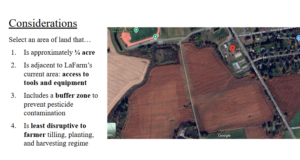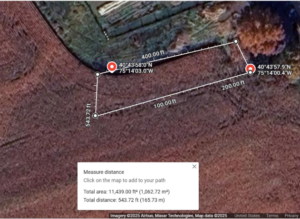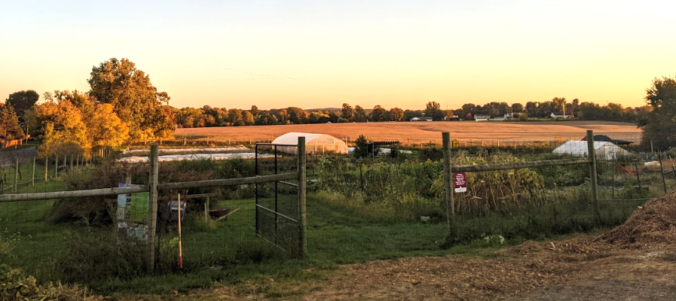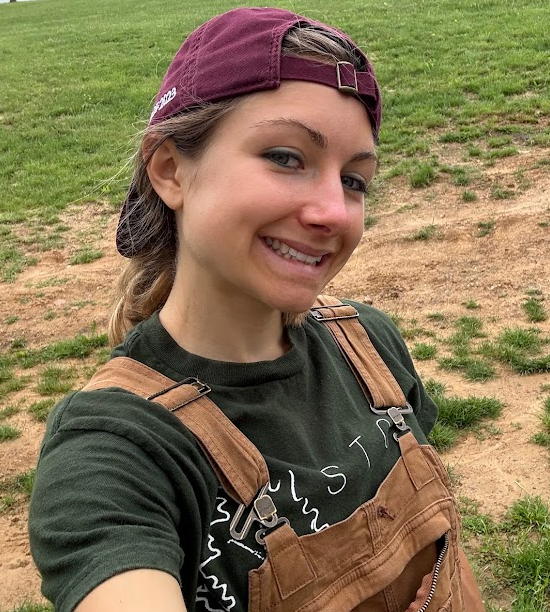12 February 2025
What I did:
This week, I attended the PASA Conference from February 5-7. Many of the sessions that I selected to go to were those that I could link to my independent study. During this week, I also continued reading Healing Grounds. To my pleasant surprise, many themes in the book came up in the sessions that I was going to at PASA. I also read two articles: “Regenerative agriculture sequesters carbon—But that’s not the only benefit and shouldn’t be the only goal” and “Regenerative agriculture needs a reckoning.” I had planned on doing another reading for this week, however, I decided that I had enough content for this week between PASA, reading Healing Grounds, and reading two articles.
What I learned:
PASA and Healing Grounds
One of the sessions I went to at PASA was titled “A Deep Dive Into Soil Biology.” Having living plants in soil for as many months out of the year as possible is critical to maintain the microbial community. Microbes rely on living roots to survive whilst plants rely on microbes to obtain nutrients necessary for survival. Roots, fungi, and bacteria have a strong symbiotic relationship. From the moment seeds germinate, they establish connections with fungi in the soil. If fertilizer is present, seeds germinate in an “artificial environment” and do not feel the need to send out root exudates to attract fungi and bacteria. Therefore, fertilizer should be applied in a sidedress so that seeds must first establish themselves with a microbial network before tapping into the readily-available nutrients. Tips of growing roots send out sugary exudates to attract nutrient-containing bacteria which “swim” along root hairs. (Bacteria require a moist soil environment in order to move about; therefore, keeping soils moist is critical to maintaining a healthy microbial community.) The root tips then encompass the bacteria, extract the nutrients, and expel them back into the soil. In Healing Grounds, I learned that arbuscular mycorrhizal fungi associate with most terrestrial plants (80% major food crops) and help with resistance to drought, pest, disease, soil aggregation, nutrient cycling. (Carlisle 94) The aforementioned statement from Healing Grounds was reiterated in this session and elaborated upon in more detail. Mycorrhizal fungi grow into most crop roots, extending the root network so plants can access more nutrients and water resources. The only crops which are not compatible with the mycorrhizal fungi are those belonging to the Brassica and Amaranthaceae families, explaining the 80% statistic that I had previously read. In order for the “underground herd” of bacteria and fungi to survive, soils must be kept moist and cool (between 85-90 fahrenheit). Practices such as mulching and cover cropping contribute to maintaining this environment when cash crops are not planted.
In one of the plenary talks, “Soil Organic Carbon” I learned that plant root inputs (sugary exudates) build soil 5-30x faster than aboveground organic material. This point further emphasizes the role that cover crops play in contributing to building soils. While mulching and composting are beneficial, living roots can contribute significantly to building soil deep within the surface.
In another talk, “Too Much of A Good Thing: Compost, Nutrients, and Watershed Health,” I learned that many farms have excess phosphorus from compost applications. Having an excess of certain nutrients in soils can contribute to eutrophication from runoff during high rainfall events. Additionally, excess of one nutrient in soil can inhibit plants’ absorption of other key nutrients. High quality compost with the right ratio of nutrients for a given field is critical to know before utilizing it. This contradicts the notion that compost is always good. This was a powerful takeaway given that Lafayette has recently started utilizing dining waste as compost on the farm, boasting of the circular food loop. Just as soil can be tested for its nutrient profile, compost can be tested. If compost is not good quality, it is better to use leaf mulch and granulated fertilizer to ensure excess of one nutrient is not degrading soil health.
Key takeaways to apply to LaFarm:
- Keep living roots in field as long as possible
- Keep soils moist and cool continuously
- Test compost for nutrient profile
- Do not plant seeds directly into fertilizer; apply fertilizer on side so that plant roots must establish before they can access it
Readings
“Regenerative agriculture sequesters carbon—But that’s not the only benefit and shouldn’t be the only goal”
Regenerative agriculture requires adaptation to what exists naturally in a system and utilizes minimal outside resources to allow a system to be regenerative, in other words, self-sustaining. Carbon sequestration can be an indicator for farmers that they are doing something right but is not the end goal of regenerative agriculture. Regenerative agriculture is all about symbiotic relationships, between people, animals, plants, microorganisms, and the land; there are no shortcuts to “achieving” regenerative agriculture.
“Regenerative agriculture needs a reckoning”
Regenerative agriculture is not just about changing the practices used on a farm or the end result of the farm’s produce or soil. Regenerative agriculture necessitates that all people be included and the systems that support conventional mechanized agriculture are dismantled because they are based on a foundation of land dispossession and racism. Without changing the foundation that conventional agriculture rests on, the ecological and environmental crisis that proponents of the mainstream regenerative agriculture movement are focused on remediating will not be solved. Exploitation and violence towards the land is directly linked to discrimination and exclusion of certain groups of people. One cannot begin to solve our ecological crisis without beginning to solve our social crisis. Regenerative agriculture is known to focus on biodiversity of plants and microorganisms, but it must also focus on diversity of people and a diversity of knowledge. Indigenous knowledge, from the beginning of settler colonialism, has been excluded and ignored. Indigenous people native to this land had experience developed over generations that allowed them to live in balance with the land. European settlers ignored and rejected the lifestyles of the Indigenous people they encountered, superimposed their practices from another continent on foreign land. There is not a lack of knowledge of how we can live in balance with the land, we have just been ignorant of it, willfully by those intent to maintain extreme power and wealth, unwillfully by those subject to the system that tries to keep them blind to the truth. There are solutions, there have been, we have just decided to live with the problems that we started for hundreds of years because at least they are our problems and we want the solutions to be our solutions. Regenerative agriculture will require humility.
What I am doing next:
After an intense week of sessions at the PASA conference, I will be reading a few articles about regenerative agriculture and continuing Healing Grounds. There will be less content that I am consuming this week which will allow me time to ponder what I have read and listened to up to this point. I would like to solidify where I will get funding for the soil tests that I want to do. Additionally, I intend to reach out to Ryan Snyder to follow up about the land I requested for my study.
Author: simioneo (Page 2 of 2)
- January 2025
- Getting access to land: Designing a compelling proposal and communicating with the individual in charge of negotiating lease terms with the conventional farmer.
- February 2025
- Designing a syllabus: Creating a list of learning goals, selecting readings– research articles and a book, making a structure for field work.
- Beginning the research with readings, writing memos to synthesize information and learning gains.
- March 2025
- Meeting with the conventional farmer to discuss the proposed study area and reworking it to accommodate his operations.
- Continuing the readings and memos.
- April 2025:
- Taking soil samples to be analyzed at Cornell Soil Health Lab.
- Presenting work at 3rd Annual Northeast Student Food and Farm Conference.
- Field work: setting up deer fence, flail mowing corn debris, broadcasting cover crop seed, incorporating seed with precision depth roller.
- May 2025
- Presenting research at Sustainability Community Meeting.
- Monitoring growth of cover crop.
- August 2025
- Flail mow spring cover crop.
A compelling budget proposal was key to securing funding for the technical part of this independent study. While I have an innate passion for regenerative agriculture, the people on the recieving end would only care about regenerative agriculture if I could demonstrate how this independent study contributes to my educational experience at Lafayette. I leveraged the college’s mission statement and pointed out how my study would not just benefit me, but also contribute to the college as a whole.
Regenerative Agriculture Budget Proposal: March 2025
Introduction:
My name is Olivia Simione, and I am a junior majoring in Environmental Science with a Spanish minor. I have worked on LaFarm for the past 3 years and graduated from the Apprenticeship program. My practical experience on LaFarm, in addition to my courses, has informed me about how to manage land sustainably and what it takes to do so. This project is an opportunity to put what I have learned into practice.
Description:
This independent study is a project that will investigate the benefits of transitioning land from a conventional agriculture model to a regenerative agriculture model by focusing on minimizing soil disturbance, maintaining vegetative soil cover, eliminating the use of synthetic agricultural chemicals, and maximizing diversity. A soil health assessment through the Cornell Soil Health Laboratory would serve as a baseline measurement of pH, Organic Matter, Nutrient profiles for P, K, Mg, Fe, Mn, Zn, Al, Ca, Cu, S, B, Soil Texture, Active Carbon, Wet Aggregate Stability, Soil Respiration, Soil Organic Carbon, Total Carbon, and Total Nitrogen. This assessment will be compared to past soil health assessments of LaFarm to evaluate the relative soil health of a land under conventional practices to land under sustainable practices. Following this initial assessment, the implementation of agricultural practices used in regenerative systems will begin. Stakes and a deer fence will be established around the perimeter of the working area to prevent animals from damaging the crops that will be grown. LaFarm’s 2-wheel tractor will be used with the Precision Depth Roller implement as a low-till method of preparing the soil for sowing cover crops. The cover crops will serve as a natural way to replenish nutrients without the use of synthetic chemicals and also serve as a vegetative cover.
Benefits to the College:
- Uphold Lafayette’s Mission: “The College fosters intellectual inquiry, artistic exploration, scholarship, and personal growth in a vibrant, diverse, and inclusive community. Lafayette students become critical thinkers, creative problem-solvers, and responsible citizens of the world.”
- Contribute to Lafayette’s Climate Action Plan: Supports two of the three main goals of the climate action plan: 1) utilize regenerative ecosystems and biodiversity, 2) zero waste and circular economics.
- Raise Lafayette’s profile across other schools in the region: Enhances leadership in sustainability, food systems, and campus farms
- Creates a space for more student research, sustainability projects, and food systems reform
- Connect curricular activities of various departments to community engagement work:
- Departments: EVST, Biology, Geology, A&S, History, Gov/Law, and more
- Classes: Land Acts, Food Studies, Intro to the Environment, Environmental Justice, Geomorphology, and more
Estimated Budget
| Soil Health Assessment | $130 + shipping |
| Spring Green Manure Cover Crop Seed | $86.50 |
| Deer fence | $450 |
| Stakes | $243 |
| Total | $909.5 + shipping |
A Framework for Anti-Colonial Regenerative Agriculture at LaFarm
Delaware Nation is a sovereign federally recognized Nation of Lenape people, whose ancestral homelands included eastern Pennsylvania. Through a fraudulent treaty, Thomas Penn stole over a million acres of land from the Lenape people, an act instrumental in their removal which continues to be protested.
The entangled values and practices we seek to apply are founded in Indigenous principles of loving-caring for the Earth. Including individuals of Delaware Nation is critical if we are to truly engage in Regenerative Agriculture on this land.
Values:
- Reciprocity: We acknowledge that we rely on beings and systems outside of ourselves. When the land gives to us, we must give back, just as when we give to the land, we expect it to give to us.
- Respect: We have an awareness of the importance of human and non-human units of this network and are thoughtful and intentional about how we treat them.
- Collective (human and non-human) wellbeing: We understand that the wellbeing of each unit of this network is critical to the wellbeing of all.
- Knowledge co-creation*: We seek to continuously learn from each other and value all backgrounds and identities.
- (Re)localization: We seek to understand the unique place where we are and pay attention to the microclimate and how the land we are working with responds to different practices.
Practices:
- Minimal soil disturbance → no-till
- Maintenance of vegetative soil cover→ cover crops grow when nothing else does
- Maximizing diversity → intercropping
- Minimizing synthetic agrichemicals → leaf mulch for organic matter, compost for nutrients, organic fertilizer as needed
Considerations when selecting an area:

Approximate area:

EVST 390-02: Regenerative Agriculture at LaFarm
Learning objectives:
- What is regenerative agriculture? What does it mean to practice regenerative agriculture?
- What is the discourse surrounding regenerative agriculture?
- How does regenerative agriculture differ from other sustainable agricultural practices?
- What does it mean to regenerate land?
- What are the Indigenous origins of regenerative practices and how may the popularized version of regenerative agriculture differ on a practical and psychological level?
EVST 390-02: Regenerating(?) Land
| Week/Topic | Reading/Viewing/Activity | Deliverable Due |
| Week 1: Jan 27-31 |
|
|
| Week 2: Feb 3-7
PASA Conference Introduction to Regenerative Agriculture
|
|
|
| Week 3: Feb 10-14
Introduction to Regenerative Agriculture:
|
|
|
| Week 4: Feb 17-21
Introduction to Regenerative agriculture:
|
|
|
| Week 5: Feb 24-28
Re-group |
|
|
| Week 6: Mar 3-7
Soil Testing: |
|
|
| Week 7: Mar 10-14
Soil Testing: -collect soil sample and ship to Cornell |
Field Work:
|
|
| Spring Break: Mar 17-21 | ||
| Week 8: Mar 24-28: |
|
|
| Week 9: Mar 31-Apr 4 |
|
|
| Week 10: Apr 7-11 |
|
Memo
|
| Week 11: Apr 14-18 |
|
Memo
|
| Week 12: Apr 21-25 |
|
|
| Week 13: Apr 28- May 2 |
|
|
| Week 14: May 5-9 | Work on Portfolio | |
| Week 15: May 16 | Complete Portfolio |

LaFarm
LaFarm is a three-acre working farm and community garden focused on diversified vegetables and flowers located 3 miles from Lafayette’s main campus. It is comprised of production fields, pollinator gardens, high tunnels (one large and one small), and a greenhouse in addition to community garden plots. LaFarm provides healthy food to campus and the surrounding community, is incorporated into classes across many disciplines, has been a site for research, and offers volunteer opportunities.
I worked on LaFarm since my first semester at Lafayette (my first farm shift was before my first class)! LaFarm has grown from a small plot to a 3-acre farm and community garden space since its beginning. Beyond LaFarm is 110 acres of farmland that is leased to a farmer who uses conventional agriculture practices to grow corn and soybeans. The land which I worked with for this independent study is a half acre of the 110 acres, just beyond the deer fence that surrounds LaFarm.


About the researcher
My name is Olivia Simione. I’ve worked on the Lafayette College Farm since my first semester at Lafayette. I grew up gardening, but wouldn’t consider myself a farmer until I came to Lafayette. I fell in love with farming immediately, more specifically, the sustainable, no-till practices that Farmer Josh had implemented since he started managing the farm a year earlier.
Practices I had learned about sustainable agriculture in my AP Environmental Science class, my senior year of high school, were happening right in front of me, and not only that, I had the privilege of contributing to this important work. From drip irrigation to mulching to diversified crop production, I was hooked; I couldn’t get enough.
I applied for the Farm Apprenticeship, a position at LaFarm that follows the Pre-Apprentice framework created by PASA, and got the job! I worked in the spring part-time, summer full-time, and fall part-time. At the annual PASA conference, I graduated from the program, earning my DVP certification in February of 2024. Despite having finished the apprenticeship, I certainly was not finished with LaFarm and continued to work every semester. In the fall of 2024, the farm was still a constant in my life.
During all this time, industrial agriculture, whose harms I was quite familiar with, was practiced by a conventional corn and soy farmer just beyond the fence of LaFarm. I had always daydreamed about transitioning some of that land to the sustainable practices observed at LaFarm, wanting to rescue it from the throes of tillage, chemical fertilizers and monocropping. But, I always thought that would be impossible and too lofty of a goal for a college student.
A conversation with one of my professors about this dream of mine helped me realize it was possible and was the push I needed to initiate my independent study for Spring 2025.